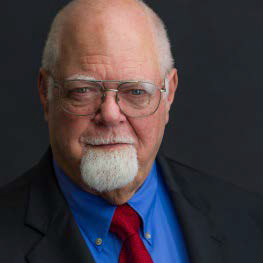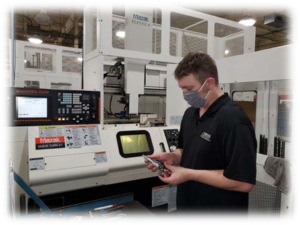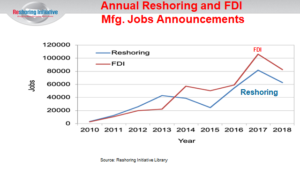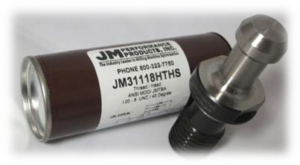In March 2020, the World Health Organization (WHO) officially declared the novel COVID-19 (coronavirus disease) outbreak a pandemic. Manufacturers are dealing with the fact that the virus has exposed the fact that many domestic (North American-based) brands rely significantly upon China for fulfilling some, part, or nearly all, of their supply chain.
Participating in this two-part “COVID-RESHORING-OPS” Q&A are two representative entities with vested interest on the subject−JM Performance Products, Inc. (JMPP: Fairport Harbor, OH) President, John Stoneback, and the Reshoring Initiative® (RI: Kildeer, Illinois) Founder & President, Harry Moser.
JM Performance Products, Inc. is a leading manufacturing innovator of CNC mill spindle optimization products since 2009. Their Patented High Torque Retention Knobs overcome a critical “loose- tool” design flaw inherent in CNC v-flange tooling that was responsible for costly CNC milling and boring issues industry wide−in terms of production, time, and tooling.
An essential element of the patented design is a knob that is longer and reaches a little deeper into the holder’s threaded bore. As a result, all thread engagement occurs in a region of the toolholder where the diameter is large, and where there is correspondingly more material to resist deformation.
The Reshoring Initiative, founded in early 2010, takes action to bring five million manufacturing jobs back to the US by helping manufacturers realize that local production, in some cases, reduces their total cost of ownership of purchased parts and tooling. The RI also trains suppliers how to effectively meet the needs of their local customers−giving the suppliers the tools to sell against lower priced offshore competitors. The RI is a nonprofit organization that offers a number of free tools to advance their mission.
Moser was inducted into the Industry Week Manufacturing Hall of Fame 2010, participated actively in President Obama’s 1/11/12 Insourcing Forum at the White House, and is also on the Commerce Department Investment Advisory Council.
1. Reshoring pre-and-post COVID-19 considerations.

MOSER: The annual rate of jobs coming from offshore increased from 6,000 in 2010 to 180,000 in 2017. The cumulative jobs brought back represent about 5% of total
U.S. manufacturing employment as of 12/31/19. The annual rate moderated in 2018-19, mainly because of President Donald Trump’s tariffs, which caused business uncertainty.
Multi-step, multi-country manufacturing was already under stress even before the coronavirus disease (COVID-19) pandemic which has severely disrupted the global logistics network. Our intellectual understanding of trade wars during this crisis now reveals the supply chain weakness–we simply don’t make enough components on our own shores. The global supply chain as we knew it is essentially a dangerous supply chain which has lead us to the current result of death and economic disaster.
STONEBACK: As manufacturing reshores and jobs open up, the need for skilled operators is going to increase. Manufacturers are going to be faced with elevated costs as they hire skilled workers, invest in training, or define new methods so that less skilled employees are able to handle the production requirements.
Companies that examine their operations at the machine shop level and take action to correct the problems at the very base will be able to forego the highly skilled individual, instead opting to employ a lesser skilled individual who will not need to make on-the-fly adjustments.
Historically, milling has required highly skilled machinists and operators because of the effects of the toolholder expansion, and need to compensate and correct for the flaw. Additionally, by taking steps to correct the flaw, via measures like our patented High Torque retention knobs, manufacturers will benefit from lower costs and higher production rates–both factors that impact their ability to bid and manufacture more competitively.
2. How is the COVID-19 crisis different than others like 9/11 or the 2008 recession in terms of reshoring & manufacturing?
MOSER: The reshoring program began in 2010 so the 9/11 crisis didn’t directly affect it. However, on the International market, import and export regulations can always be a hurdle for finding the right suppliers. This was especially true for US businesses after 9/11. The extra time and money spent on certifying a supplier for regulations like the Customs Trade Partnership Against Terrorism (C-TPAT) is another trade-off that management must consider when diversifying their supply chain.
The financial crisis of 2008 drove OEMs to essentially not buy anything. On-hand plus pipeline inventory from Chinese suppliers might total 3-6 months usage, if you get it locally, it’s 3-6 weeks. Additionally, big companies are more resistant to recession and can handle the problem of low sales much better. China pays in advance, and the US pays 60-90 days after shipment so there’s more control during a disaster.
The supply chain math is obvious, and developing domestic partnerships is the new reshoring. Customers, in most cases, are willing to pay a premium for on-time, as-promised delivery commitments. The goal is to convince companies to do the math and decide what to reshore now.

STONEBACK: This crisis has made the entire Country aware of our supply chain issues. Many consumers were blissfully unaware that our nation is dependent upon China and other Eastern countries for so many commodities such as pharmaceuticals, textiles, medical devices, and even food. Our lack of preparedness and inability to secure life-saving equipment and supplies opened many eyes. In past crises, the supply chain was not as critically impacted. The general population is now calling for reform, and it is up to North American manufacturers to reduce the risks of a broken supply.
3. Can COVID-19 be a positive/progressive factor for reshoring?
MOSER: I believe this can become a real opportunity to drive publicity about reshoring. It reminds me of an infamous quote from former Chicago mayor and chief of staff to President Barack Obama, Rahm Emanuel, during the 2008 financial collapse in an attempt to highlight that the government can learn from its mistakes when dealing with crises. Amid negotiations over how lawmakers should respond to the current COVID-19 pandemic, he recently reprised the quote, “Never allow a crisis to go to waste…start planning for the future.”
STONEBACK: We concur with Harry Moser that this can become a very real opportunity to drive publicity about reshoring to domestic manufacturers. This situation uniquely provides the catalyst for manufacturers to reexamine how they buy and how they manufacture. There is an imminent new demand that is emanating from the consumer level to make changes. A new understanding that the least expensive supply or manufacturing options may ultimately bare the highest risks will add a new dimension to cost analysis. There will hopefully be a migration at the consumer level from purchasing the least expensive articles to purchasing fewer items, but those that are domestically manufactured and better quality.
4. Which markets/industries are most susceptible to COVID-19 and would benefit most from reshoring?
 MOSER: Shortages of medical products due to 90-to-95% dependence on imports (especially from China) make medical and pharmaceutical markets the obvious top priority targets which bridge over to OEMs for components. When the COVID-19 pandemic ends, America’s global supply chain must be replaced with local and national sourcing but it won’t just be in health care. Other leading industries of focus include: transportation equipment, appliances, plastic and rubber products, fabricated metal products, electronics, and apparel.
MOSER: Shortages of medical products due to 90-to-95% dependence on imports (especially from China) make medical and pharmaceutical markets the obvious top priority targets which bridge over to OEMs for components. When the COVID-19 pandemic ends, America’s global supply chain must be replaced with local and national sourcing but it won’t just be in health care. Other leading industries of focus include: transportation equipment, appliances, plastic and rubber products, fabricated metal products, electronics, and apparel.
Medical supplies accounted for roughly $53 billion worth of US imports last year. Reshoring production for half of those supplies could generate an additional 302,000 jobs and add $534 billion to the GDP.
STONEBACK: The mold making industry in this country undeniably took a heavy hit due to off-shoring production. Reshoring would allow for higher quality, longer life, and faster response to opportunities. Having the ability to reduce costs in mold production, along with the reduction of transportation costs, would put mold makers in a stronger, more sustainable competitive position.
5. Medical components are key…how can JMPP’s HTRKs help this issue?
 MOSER: Innovations such as JMPP’s patented High Torque retention knobs (HTRK) are vital to the solution as they can speed up productivity and delivery for these in-demand components. A recent example of this would be Bill Berry, President and Owner of Die-Tech & Engineering (DTE) in Wyoming, who was able to provide die-casting dies for ventilator parts for GM in less than one week that was holding up the production of ventilators.
MOSER: Innovations such as JMPP’s patented High Torque retention knobs (HTRK) are vital to the solution as they can speed up productivity and delivery for these in-demand components. A recent example of this would be Bill Berry, President and Owner of Die-Tech & Engineering (DTE) in Wyoming, who was able to provide die-casting dies for ventilator parts for GM in less than one week that was holding up the production of ventilators.
STONEBACK: In addition to speeding up productivity and delivery, the High Torque retention knobs also reduce costs–allowing US manufactures to be more agile in pricing and competitive bids.
6. What opportunities/pitfalls does this represent for domestic manufacturers?
MOSER: COVID-19 is a valuable wake-up call as it really reveals our weaknesses and ultimately what we can, and need, to do. There’s substantial interest from the administration to build up US manufacturing, therefore we need to push for more funding for proactive organizations and programs that are in place, that can help in the process of reshoring.
Notably, Manufacturing Extension Partnerships (MEP) is a national network of dozens of specialists in each state who understand the needs of America’s small manufacturers. Also, the Coronavirus Aid, Relief, and Economic Security (CARES) Act provides fast and direct economic assistance for American workers, small businesses, and preserves jobs for American industries. These are vital programs that can help manufacturers select the US now in focusing on reshoring.
7. What is JMPP doing to promote the benefits of their products during and post COVID-19?
STONEBACK: We are rebranding to more effectively convey our dedication to reshoring efforts. All of our products are made in the USA, with a commitment to source our materials domestically. The company has been in manufacturing for over 65 years, without having to rely on foreign manufacturing support.
Ultimately, our goal is to promote the products benefits by educating the industry. Every milling machine company has the ability to improve their milling results and efficiencies easily and affordably– ultimately saving them time, money, and making them more competitive. We are hoping that rebranding along with a renewed push to education will successfully communicate our message.
8. How can domestic manufacturers offset costs vs. offshoring post COVID-19?
 MOSER: The key is to calculate and measure costs correctly. Take a look at key reshoring factors like duty freight, the cost of inventory, travel, etc., and how that impacts total costs and factor that in. Then, you can also factor in reshoring savings like Trump tariffs, etc., as well as cost savings from state-side technology production efficiencies like JM Performance Products’ HTRKs, that can drive those numbers higher.
MOSER: The key is to calculate and measure costs correctly. Take a look at key reshoring factors like duty freight, the cost of inventory, travel, etc., and how that impacts total costs and factor that in. Then, you can also factor in reshoring savings like Trump tariffs, etc., as well as cost savings from state-side technology production efficiencies like JM Performance Products’ HTRKs, that can drive those numbers higher.
STONEBACK: Fewer interruptions to the process yields high production and lower costs. Reduction in secondary or additional processes not only positively impacts the cost per unit, but also impacts the cost associated with handling the product multiple times. Any reduction in production cost impacts the manufacturer’s competitive edge.
9. How does COVID-19 affect the global supply chain landscape?
MOSER: Having relegated the supply chain to China for the better part of the past decade, some companies already started taking steps last year to divest their over-reliance on Chinese parts. This was prompted by the trade war. Some companies shifted low-cost parts acquisition to Vietnam and others to Mexico.
Global Trade as a percentage of world Gross Domestic Product (GDP) over the last 3-4 years was slowing, and already plateauing before COVID-19. This decline was because companies were beginning to realize that depending on other countries wasn’t the economic or ‘green’ solution long term. So the focus was trending towards localization/regionalization even before the global pandemic.
The mission is to bring five million manufacturing jobs to the U.S. from offshore. By balancing the $800 billion US trade deficit we’d create approximately 5 million jobs–a 40% increase at current levels of productivity.
According to our Reshoring Initiative study, manufacturing jobs via reshoring by U.S. companies and through foreign direct investment (FDI) grew to 180,000 in 2017, the fastest rate in history. That’s up 50% from 2016 and 2,800%from 2010. This must continue in the post COVID-19 economic landscape, and the US should leverage more outsourcing from Mexico versus China if the US isn’t an option.
10. Will this crisis shift/influence the higher cost vs. lower risk equation of reshoring?
MOSER: When people reshore, they accept a higher US cost, but reduction in overhead (inventory, travel, international property, etc.). The bottom line is to reshore the products where the savings on overhead and risk is greater than the increase in manufacturing cost.
STONEBACK: Effectively reducing the manufacturing costs, along with reduction in overhead costs, will ultimately lower the higher costs people have to accept.
About JM Performance Products, Inc.
Established in 1966, JM Performance Products, Inc. (JMPP) has firmly established itself as a leading manufacturer of CNC mill spindle optimization products. Across a myriad of markets, JMPP is dedicated to reshoring with over 500 styles of patented Retention Knobs for BT, DIN, ISO, and CAT toolholders from 30 taper to 60 taper−all manufactured and material sourced in the United States! All products in the integrated suite are engineered to optimize milling machine performance including: improving finishes, eliminating run-out, reducing chatter and harmonics, decreasing set-up times, extending tool life, and increasing spindle performance.
For more information, visit www.jmperformanceproducts.com



















